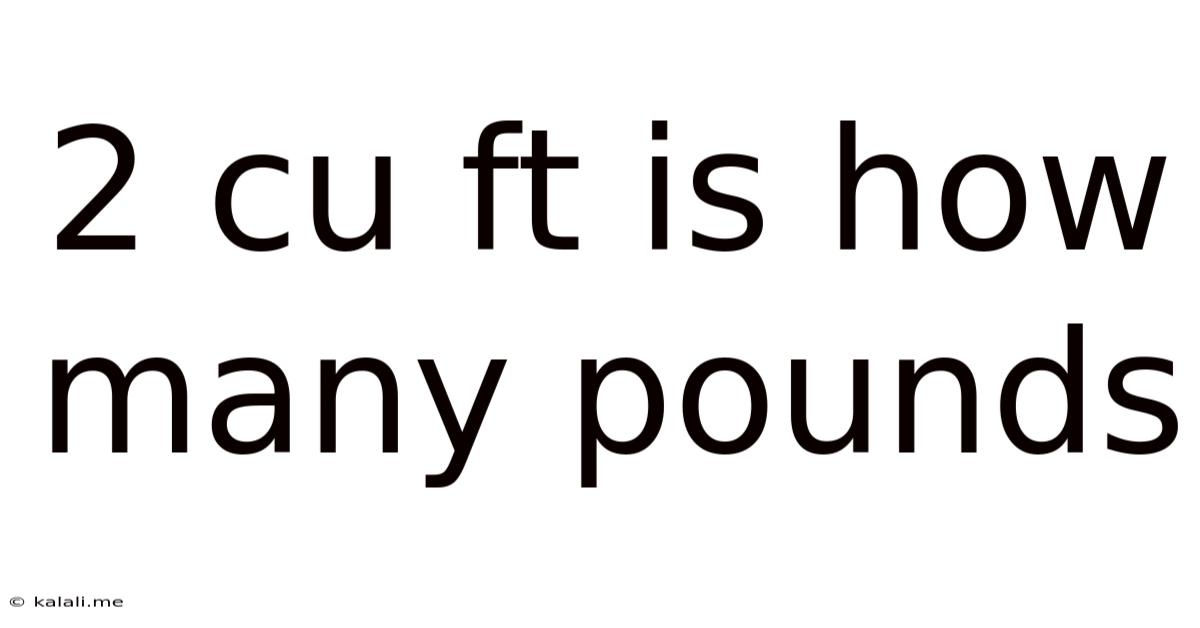2 Cu Ft Is How Many Pounds
Kalali
Jul 31, 2025 · 4 min read

Table of Contents
2 Cubic Feet is How Many Pounds? Understanding Volume and Weight Relationships
Understanding the relationship between volume (measured in cubic feet) and weight (measured in pounds) is crucial in various fields, from shipping and logistics to material science and engineering. This article will delve deep into answering the question, "2 cubic feet is how many pounds?", explaining why there's no single answer and outlining the factors that determine the weight of an object occupying 2 cubic feet of space. We'll explore different materials, densities, and practical examples to provide a comprehensive understanding of this fundamental concept.
The Missing Piece: Density
The key to understanding the weight of a 2 cubic foot volume lies in density. Density is defined as the mass per unit volume of a substance. It's typically expressed in units like pounds per cubic foot (lb/ft³) or kilograms per cubic meter (kg/m³). Different materials have vastly different densities. For example, a cubic foot of feathers weighs significantly less than a cubic foot of lead. Therefore, without knowing the density of the material filling the 2 cubic feet of space, it's impossible to determine its weight in pounds.
Calculating Weight from Volume and Density
The fundamental formula connecting volume, density, and weight is:
Weight (lbs) = Volume (ft³) x Density (lbs/ft³)
Using this formula, we can calculate the weight if we know the density of the material. Let's explore some examples:
Example 1: Water
The density of water is approximately 62.4 lbs/ft³. Therefore, 2 cubic feet of water would weigh:
Weight = 2 ft³ x 62.4 lbs/ft³ = 124.8 lbs
Example 2: Dry Sand
Dry sand has a density that varies depending on its composition and compaction, but a typical value is around 100 lbs/ft³. Therefore, 2 cubic feet of dry sand would weigh approximately:
Weight = 2 ft³ x 100 lbs/ft³ = 200 lbs
Example 3: Wood (Pine)
The density of pine wood varies depending on the species and moisture content, but a common value is around 30 lbs/ft³. Therefore, 2 cubic feet of pine wood would weigh approximately:
Weight = 2 ft³ x 30 lbs/ft³ = 60 lbs
Example 4: Steel
Steel has a much higher density than wood or sand, typically around 490 lbs/ft³. Two cubic feet of steel would therefore weigh:
Weight = 2 ft³ x 490 lbs/ft³ = 980 lbs
These examples clearly demonstrate the dramatic impact of density on weight. Two cubic feet of space can contain vastly different weights depending on the material.
Factors Affecting Density and Weight
Several factors can affect the density and therefore the weight of a material within a given volume:
-
Material Composition: Different materials have inherently different densities. Metals are generally denser than wood, which is denser than air.
-
Moisture Content: The presence of moisture significantly impacts the density of many materials, especially porous ones like wood. Wet wood is denser than dry wood.
-
Temperature: Temperature changes can slightly alter the density of some materials. Generally, materials become less dense as temperature increases.
-
Compaction: The degree of compaction of a material, particularly granular materials like sand or soil, significantly influences its density. More tightly packed material will have a higher density.
-
Pressure: High pressure can compress materials, increasing their density and therefore their weight per unit volume.
Practical Applications and Considerations:
Understanding the volume-weight relationship is crucial in various real-world scenarios:
-
Shipping and Logistics: Shipping companies use volume-weight calculations to determine shipping costs. They often use a dimensional weight, which takes into account the volume of the package, even if it's not fully filled. This ensures fair pricing for bulky, lightweight items.
-
Construction and Engineering: Engineers need to consider the weight of materials when designing structures, calculating loads, and ensuring structural integrity. Accurate density values are essential for these calculations.
-
Material Science: Researchers studying material properties often use density as a key parameter in characterizing materials and predicting their behavior under different conditions.
-
Environmental Science: Density plays a role in understanding sediment transport, water flow, and other environmental processes.
-
Packaging and Storage: Knowing the weight of the contents is vital for efficient packaging, storage, and handling. This helps optimize space utilization and prevent damage during transport.
Beyond Simple Calculations: Dealing with Irregular Shapes
The examples above assume simple, regular shapes. However, in many real-world situations, we deal with objects of irregular shapes. Calculating the volume of such objects can be more challenging and may require techniques such as water displacement or 3D scanning.
In Conclusion: There's No Single Answer
The question "2 cubic feet is how many pounds?" doesn't have a single definitive answer. The weight depends entirely on the density of the material occupying that volume. By understanding the concept of density and using the appropriate formula, we can accurately calculate the weight of any material given its volume and density. Remember to consider the various factors that can influence density for accurate and practical results in real-world applications. This understanding is crucial in many fields, from everyday tasks to complex engineering projects. Remember to always account for the density of the material you are working with for the most accurate weight estimation.
Latest Posts
Latest Posts
-
How To Beat Level 11 On Use Boxmen
Jul 31, 2025
-
How Many Square Feet In Box Of Vinyl Siding
Jul 31, 2025
-
How Much Is 125 Pounds In Kilos
Jul 31, 2025
-
How Many Cups Blueberries In A Pound
Jul 31, 2025
-
What Value Of N Makes The Equation True
Jul 31, 2025
Related Post
Thank you for visiting our website which covers about 2 Cu Ft Is How Many Pounds . We hope the information provided has been useful to you. Feel free to contact us if you have any questions or need further assistance. See you next time and don't miss to bookmark.